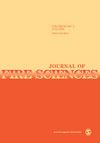消防废水中氰化氢的定量分析
IF 1.9
4区 工程技术
Q2 ENGINEERING, MULTIDISCIPLINARY
引用次数: 1
摘要
氰化氢通常是含氮材料火灾排放物中最具毒理学意义的成分。与其他主要窒息剂一氧化碳不同,在危险浓度及以上的情况下,用于连续氰化氢定量的传感器在商业上是不可用的。本文通过氯胺-T/异烟酸比色定量氰化氢,对起泡器溶液中捕获的消防废水进行了分析。起泡器样品与比色试剂混合,以产生对氰化物离子的蓝色染料。提出了一种由氰离子生成蓝色染料的新反应方案。发现稀释的标准氰化物溶液在储存长达1小时后是稳定的 年对于储存在5°C至21°C之间长达31天的样品,消防废水通过的碱性起泡器溶液显示出一致的氰化物浓度 采样后天。研究了可能存在于消防废水溶液样品中的其他常见离子(CO32-、SO32-、SO4 2-、NO2−和NO3-)的潜在干扰影响。最显著的干扰是亚硫酸盐,在10 mg L−1SO32−浓度。本文章由计算机程序翻译,如有差异,请以英文原文为准。
Quantification of hydrogen cyanide in fire effluent
Hydrogen cyanide is often the most toxicologically significant component in fire effluents from nitrogen-containing materials. Unlike the other major asphyxiant, carbon monoxide, sensors for continuous hydrogen cyanide quantification, at and above dangerous concentrations, are not commercially available. This article investigates the analysis of fire effluent captured in bubbler solutions, by colorimetric quantification of hydrogen cyanide using chloramine-T/isonicotinic acid. The bubbler samples were mixed with colorimetric reagents to give a blue dye in response to cyanide ions. A novel reaction scheme accounting for the formation of the blue dye from cyanide ions is presented. Dilute, standard cyanide solutions were found to be stable after storage for up to 1 year. Alkaline bubbler solutions, through which the fire effluent has passed, showed consistent cyanide concentrations, for samples stored between 5°C and 21°C, for up to 31 days after sampling. The effect of other common ions likely to be present in fire effluent solution samples (CO32−, SO32−, SO42−, NO2− and NO3−) was investigated for their potential interference. The most significant interference was sulphite which reduced the apparent cyanide concentration by 13% at 10 mg L−1SO32− concentration.
求助全文
通过发布文献求助,成功后即可免费获取论文全文。
去求助
来源期刊

Journal of Fire Sciences
工程技术-材料科学:综合
CiteScore
4.00
自引率
0.00%
发文量
14
审稿时长
2.5 months
期刊介绍:
The Journal of Fire Sciences is a leading journal for the reporting of significant fundamental and applied research that brings understanding of fire chemistry and fire physics to fire safety. Its content is aimed toward the prevention and mitigation of the adverse effects of fires involving combustible materials, as well as development of new tools to better address fire safety needs. The Journal of Fire Sciences covers experimental or theoretical studies of fire initiation and growth, flame retardant chemistry, fire physics relative to material behavior, fire containment, fire threat to people and the environment and fire safety engineering. This journal is a member of the Committee on Publication Ethics (COPE).
 求助内容:
求助内容: 应助结果提醒方式:
应助结果提醒方式:


